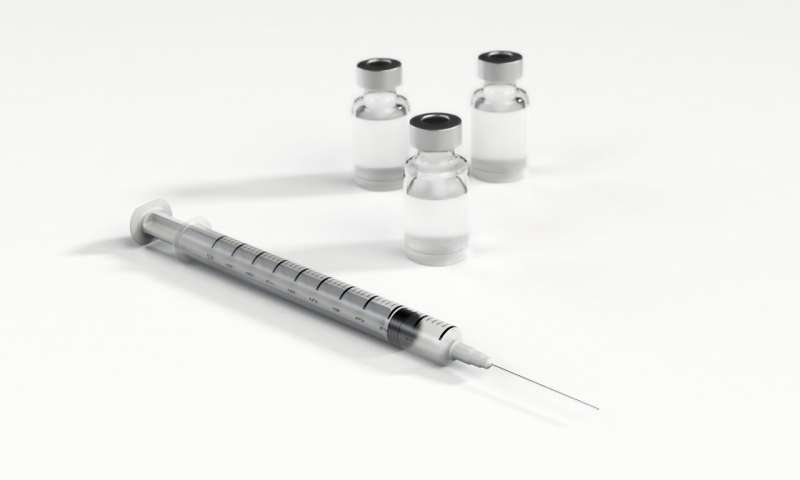Credit: Pixabay/CC0 Public Domain
A majority of parents of children 18 or younger in the New York area are likely to get their children vaccinated against COVID-19, according to new data recently collected in a CUNY SPH survey on COVID-19 vaccine acceptance in New York State's lower nine counties.
Parents made up 39 percent of the 1,000 respondents surveyed in September 2021 across the Bronx, Brooklyn, Nassau, Manhattan, Queens, Staten Island, Rockland, Suffolk, and Westchester.
Thirty-two percent of survey respondents had a child 12 to 18 years old. Among them, 51 percent had either gotten their child vaccinated with at least one dose or were very likely to get them vaccinated against COVID-19, and an additional 13 percent were somewhat likely to do so. Among the 27 percent of respondents with a child under 12 years old, 56 percent were very or somewhat likely to get them vaccinated.
The results may foreshadow parents' responses to last week's news that federal health officials gave final approval to the Pfizer-BioNTech vaccine for children ages five to 11.
"Parental support of the vaccine for children will prove to be a giant leap forward in the fight against the COVID-19 pandemic," says Dr. Ayman El-Mohandes, CUNY SPH Dean and a lead author of the survey. "We must protect every precious child. With every family member immunized there is a significantly lowered risk of exposure to the virus and its variants, which is especially heartening as we look forward to family gatherings around the upcoming holidays. "
The report tracked vaccine acceptance in the region among adults of all ages: 68 percent of all respondents had received at least one dose themselves. Conversely, 32 percent of respondents had not yet received the first dose of a COVID-19 vaccine—nearly half of whom (48 percent) were very likely or somewhat likely to get the vaccine in the future.
"Now is the time to stop the virus in its tracks and these survey results give us some guidelines on how to do that," says Dean El-Mohandes. "As long as the virus has the chance to live, it can generate variants that can be nefarious or even more fatal than we have seen before."
Notable differences in vaccination were reported among insured and uninsured respondents. Six percent of participants did not have health insurance. Only one in four (25 percent) of those uninsured respondents had received at least one dose of the vaccine, compared to 71 percent of those with health insurance. Among the unvaccinated respondents, those without health insurance were slightly more likely to express intent to get vaccinated than uninsured respondents (49 percent versus 46 percent).
The survey inquired into reasons for not yet receiving a COVID-19 vaccine. These respondents expressed feelings of fear, of vaccine safety, side effects, or of the vaccine in general, or mistrust in the COVID-19 vaccine development process, clinical trials, or effectiveness. Many participants believed there was no need to get vaccinated. For most, this was because they had already been infected with COVID-19.
Beyond those feelings, the survey discovered regulatory, logistical and childcare roadblocks. Of the 25 percent of respondents reporting barriers, 35 percent of that group said the lack of child or dependent care was their top barrier to getting vaccinated, 19 percent did not know where to get the vaccine, and 13 percent did not know how to sign up for an appointment.
Other factors were found to influence decisions about the vaccine:
- Loss of a loved one may increase the likelihood of getting a COVID-19 vaccine. Nearly one in four (24 percent) of participants reported that they had lost a loved one due to COVID-19. Those who experienced the death of a close family or friend from COVID-19 were 50 percent more likely to be vaccinated than those who did not lose a loved one (15 percent versus 10 percent).
- Chronic health conditions. Having a chronic health condition did not seem to affect vaccination acceptance. However, unvaccinated participants with chronic health conditions were more likely to express the intent to get vaccinated in the future (53 percent) compared to participants with no chronic conditions (42 percent).
- Overall access to social services. 40 percent of respondents reported needing better access to social services. Among them, food (38 percent) or housing assistance (27 percent) were most needed. In a separate question on health service needs, 52 percent of respondents reported needing better access to health services. Thirty percent said they needed better access to mental health services; 27 percent said wellness, followed by dental care (26 percent) and general medical care (26 percent).
"We know that people do not make decisions in a vacuum. As part of our continued outreach to our New York neighbors, we must understand the challenges they are facing and consider how to mitigate them as part of our campaign against the pandemic," Dr. El-Mohandes says.
How the boroughs compared:
Manhattan had the highest rate of vaccination with 79 percent of participants already vaccinated with at least one dose. This was followed by Nassau (74 percent), Queens (74 percent), and Westchester counties (73 percent).
Rockland, Suffolk, and Staten Island showed the lowest rates of vaccination and the lowest likelihood that unvaccinated respondents will receive the vaccine in the future. Among those who remain unvaccinated in those three counties, 36 to 58 percent reported that they are not very likely or not at all likely to get vaccinated
Overall, Asian and White participants had the highest rates of vaccination, at 73 percent and 72 percent, respectively. Sixty-five percent of Latino/a and 60 percent of Black participants reported having already received at least one dose. Among unvaccinated Black participants, 51 percent said they were very or somewhat likely to receive the vaccine, while 23 percent remained not very likely or not at all likely to get vaccinated in the future.
More information: Survey: sph.cuny.edu/wp-content/upload … t_September_11.2.pdf
Provided by CUNY Graduate School of Public Health and Health Policy
























